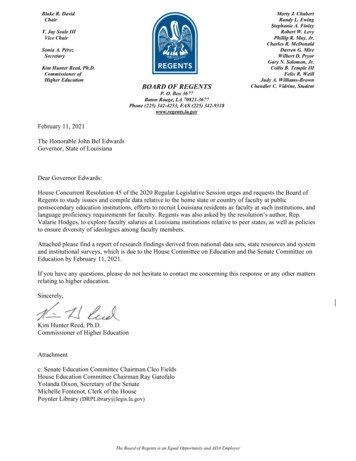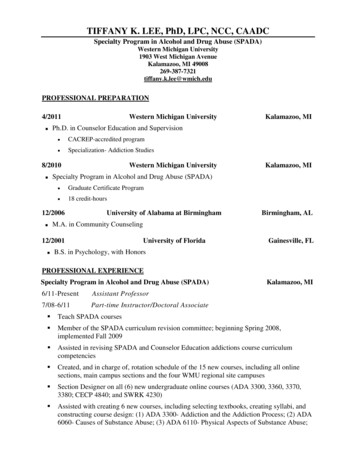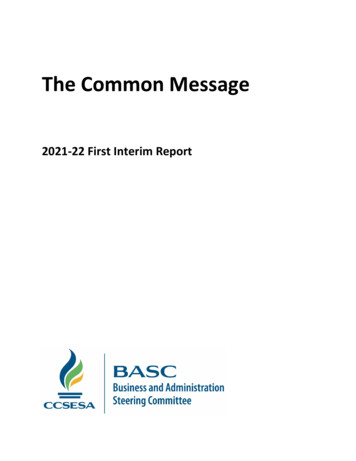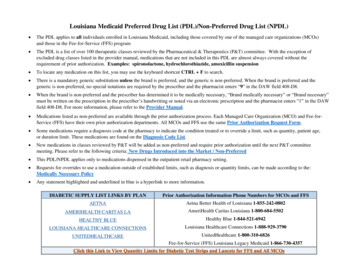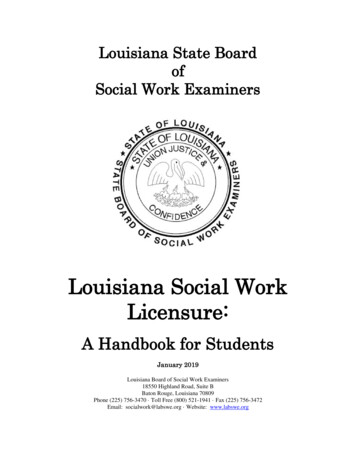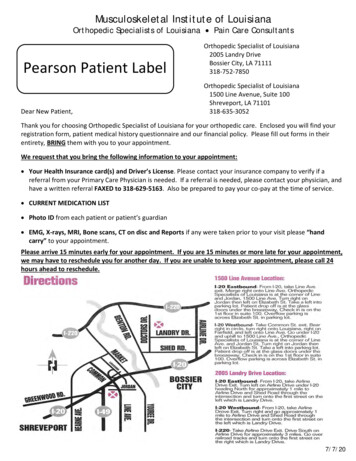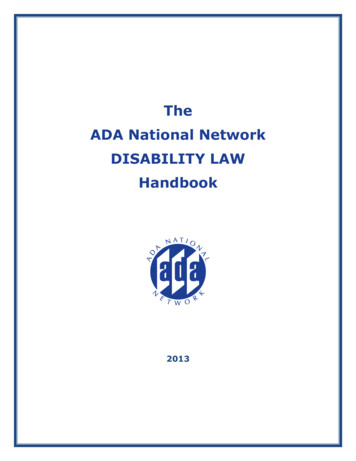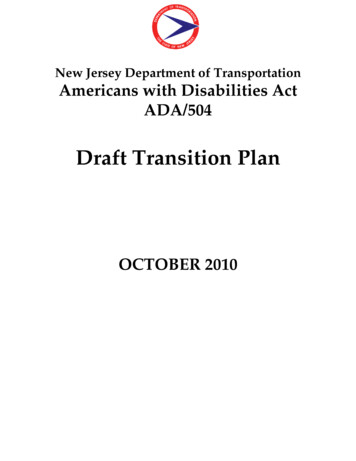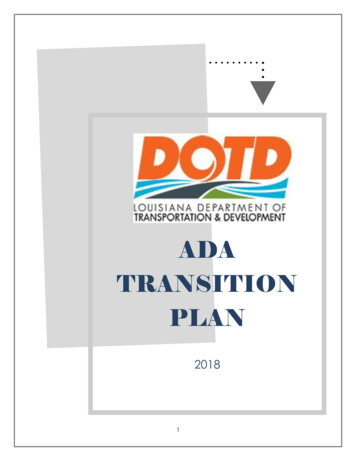
Transcription
ADATRANSITIONPLAN20181
The Louisiana Department of Transportation and Development (LADOTD) has workedcollaboratively with a consultant to gather an inventory of sidewalks, signals, buildings, parking,rest areas, mixed used trails, and linkages to transit on all state routes. This vast inventory has beengathered into a database and serves as the Transition Plan to guide the Department’s efforts ineliminating barriers that are not compliant with ADA standards.The Federal Highway Administration has cooperatively provided their support and guidancethroughout this ongoing effort.LADOTD is taking a progressive approach to prioritize, plan, and invest in the elimination of thesebarriers. The Transition Plan is a living document and will be updated regularly to track theDepartment’s progress and achievements toward compliance. LADOTD encourages publicinvolvement as ongoing efforts are made to identify and eliminate ADA deficiencies.Heather HuvalADA/Title VI Compliance Program ManagerLouisiana Department of Transportation and Development2
Table of ContentsPageAbout the Louisiana Department of Transportation and Development4Introduction and Overview6Transition Plan Requirements9Background of LADOTD's Self-Evaluation and Transition Plan10Public Meetings11The Data12Facilities/Buildings12Pedestrian Rights-of-Way Along State Routes12Public AccessADA Database13Compliance SharePoint Site13Program Access Request Form13District ADA Liaisons13Addressing the Deficiencies15Construction Program15ADA Project Selection Team15ADA Advisory Group153
About the Louisiana Department of Transportation and DevelopmentThe Louisiana Department of Transportation and Development (LADOTD) serves thetransportation and water resource needs of Louisiana residents, businesses andgovernment partners. We are committed to teamwork, quality, integrity, professionalism,innovation and excellence in serving our customers.Louisiana Department of Transportation and Development1201 Capitol Access RoadBaton Rouge, Louisiana 70802Telephone: (225)379-1232Email: dotdcs@la.govWebsite: http://www.dotd.la.govSecretary: Shawn Wilson, Ph. D.VisionTo move Louisiana onward by delivering a safe and innovative multimodaltransportation and infrastructure system.MissionPlan, design, build and sustain a safe and reliable multimodal transportation andinfrastructure system that enhances mobility and economic opportunity.ValuesEfficiencyAbility to accomplish goals with the minimal use of resourcesHonestyMoral character connoting integrity, truthfulness, and straightforwardnessInclusionValuing the perspectives and contributions of all people, and striving toincorporate the needs and viewpoints of diverse communities into all aspects ofthe organization4
QualityThe degree of excellence by which an individual, object, or project meets orexceeds requirementsDedicationA complete and wholehearted devotion to a task or organizationCommitmentBeing bound or obligated to a particular cause, action, or attitudeDepartmental Goals Deliver Quality Customer Service Enhance Public Trust Produce Tangible Infrastructure Improvements5
Introduction and Overview of LADOTD’s ADA ProgramThe Americans with Disabilities Act of 1990, or “ADA”, prohibits unjust discriminationagainst individuals based on disability and ensures that people with disabilities haveequal rights and opportunities as able bodied individuals.The ADA consists of five titles that address different aspects of public life which couldpotentially be impacted by discrimination: Title I- Equal Employment Opportunity for Individuals with DisabilitiesTitle II- Nondiscrimination on the Basis of Disability in State and Local GovernmentServicesTitle III- Nondiscrimination on the Basis of Disability by Public Accommodationsand in Commercial FacilitiesTitle IV- Telecommunications Relay ServicesTitle V- ADA Miscellaneous ProvisionsTitle II of the ADA focuses on discrimination by all public entities at the local level andspecifically addresses accessibility to public services and public transportation bypersons with disabilities.Under Title II, LADOTD is responsible for complying with the following minimumrequirements of an ADA program:Designate an ADA Coordinator:The role of the ADA Coordinator is to manage all programs and policies related tocompliance with the Americans with Disabilities Act (ADA), Section 504 of theRehabilitation Act of 1973, Title II, Title VI, and other federal and state laws associatedwith regulations for persons with disabilities. The ADA Coordinator will serve as the primarycontact for all public outreach pertaining to discriminations against persons of disabilities.The ADA Coordinator will address and investigate complaints and track the progress ofthe Transition Plan.LADOTD’s ADA Coordinator:Heather HuvalTitle VI/ADA Compliance Program ManagerLouisiana Department of Transportation & DevelopmentCompliance Programs OfficeTelephone: 225-379-1923Fax 225-379-1865email: Heather.huval@la.gov6
Provide Title VI Notice to the Public:The Title VI Notice to the Public states that services and programs offered by publicentities, including LADOTD, should be accessible to all individuals in accordance with TitleVI of the Civil Rights Act. The notice includes contact information for the Department’sADA Coordinator, as well as information about filing a formal Title VI/ADA complaint. Ata minimum, LADOTD’s ADA Notice to the Public is posted on LADOTD’s website, inLADOTD Headquarters buildings and in sub-recipient transit vehicles.Establish a Formal Complaint/ Grievance Procedure:Any individual, group of individuals or entity that believes they have been discriminatedagainst on the basis of race, color, national origin or disability by the LADOTD may file aTitle VI/ ADA complaint by completing and submitting the agency’s Title VI/ ADAComplaint Form.Any individual having filed a complaint or participated in the investigation of a complaintshall not be subjected to any form of intimidation or retaliation. Individuals who havecause to believe that they have been subjected to intimidation or retaliation can file acomplaint of retaliation following the same procedure for filing a discriminationcomplaint.A description of the timeframes and processes to be followed by the complainant andLADOTD is included in the form.At a minimum, LADOTD’s Title VI/ADA Complaint Form and Procedures can be found inthe Agency’s Title VI Plan, on the LADOTD web site and is distributed to all subrecipients.Develop Internal Standards, Specifications and Design Details7
Perform a Self-Evaluation and Develop an ADA Transition PlanThe ADA and Section 504 require State and local governments with 50 or moreemployees to perform a self-evaluation of their current services, policies and practicesthat do not meet current ADA standards. A transition plan addressing these deficienciesmust be developed once the deficiencies are identified in the self-evaluation.LADOTD is committed to making its programs and services accessible to persons withdisabilities. The goal is to achieve program accessibility and full compliance in newconstruction and alterations unless it is technically infeasible or it represents an unduefinancial and administrative burden. As part of its ongoing commitment to making itsprograms and services accessible, LADOTD has performed a self-evaluation of itsbuildings and facilities as well as its public rights-of-way. The agency will utilize themethods it deems necessary to achieve its goal. These methods can include but are notlimited to reassignment of services, modification of existing facilities, etc.8
ADA Transition Plan RequirementsThe Federal Highway Administration (FHWA) looks for the following minimumrequirements in a comprehensive self-evaluation and transition plan, as stated in 28 CFR35.150(d) :1. Clearly identify the official responsible for implementation of the transition plan2. Inventory of barriers (identification of physical obstacles): Identify intersectioninformation, including curb ramps and other pedestrian elementsAction plan to develop inventory of sidewalks (slopes, obstructions, protrudingobjects, changes in levels, etc.), signals (APS), bus stops (bus pads), buildings,parking, rest areas (tourist areas, picnic areas, visitor centers, etc.), mixed usetrails, linkages to transit3. Schedule: Show a strong commitment toward upgrading ADA elementsidentified in inventory in short term (planned capital improvement projects) andstrong commitment over time toward prioritizing curb ramps at walkways servingentities covered by ADAInclude prioritization information, planning and investments directed ateliminating other identified barriers over time4. Methods: Corrective action to make the facilities accessible should be describedin detail9
Background of LADOTD’s Self-Evaluation and Transition PlanIn 2010, LADOTD hired a consultant to perform a state-wide self-evaluation onapproximately 844 miles of pedestrian rights-of-way along State routes, includingpedestrian/ bike trails, tunnels and overpasses, as well as buildings and facilities operatedby LADOTD and provide a transition plan in accordance with the ADA, Title II/Section 504for Public Rights-of-Way using the Department of Justice, ADA and Public Rights-of-WayAccessibility Advisory Committee (PROWAAC) guidelines.For the self-evaluation, the consultant agreed to physically inspect the public pedestrianrights-of-way provided by the nine LADOTD Districts for accessibility evaluation,information and data collection. The barriers identified included, but were not limited to,space allowance and reach ranges, accessible route, protruding objects, ground andfloor surfaces, curb ramps, ramps, controls and operating mechanisms and signage. Theconsultant determined existing conditions and non-compliant barriers to access withexact location by identifying the control section.Once the self-evaluation was complete, the consultant would develop a comprehensivetransition plan using ADA Title II Section 504 guidelines. The transition plan includes theself-evaluation identifying barriers to access in the public rights-of-way, the scope of workwith the proposed corrections, the estimated construction time for providing curb ramps,deficiencies to be mitigated and steps to complete the proposed corrections, theestimated construction time for providing curb ramps, deficiencies to be mitigated andsteps to complete the proposed corrections, the official responsible for theimplementation plan and an ArcGIS file geodatabase containing feature classesdepicting the results of the areas in the transition plan.10
Public MeetingsDuring the initial stages of the Self-Evaluation/ Transition Plan project, nine (9) PublicMeetings were held to give the general public an opportunity to provide feedback,request information or provide comments.The meetings were held at each of the LADOTD District Offices throughout the State onthe following dates: District 02 (New Orleans)District 03 (Lafayette)District 04 (Bossier City)District 05 (Monroe)District 07 (Lake Charles)District 08 (Alexandria)District 58 (Chase)District 61 (Baton Rouge)District 61 (Hammond)May 17, 2011December 16, 2010February 15, 2011January 25, 2011May 18, 2011February 16, 2011January 26, 2011December 15, 2010May 17, 2011The meetings were held at accessible facilities. Special accommodations such astranslators, closed captioning and maps were made available if requested in advance.Public Meeting notices were distributed to Metropolitan Planning Organizations, City andParish Local Governments and advocacy groups in each District.Advocacy groups who were notified of the meetings included Veterans Affairs, LouisianaCommission for the Deaf, Louisiana Governor’s Office of Disability Affairs, LouisianaRehabilitation Services and Louisiana Developmental Disabilities Council.Meeting notices were also advertised in local newspapers.Additionally, information regarding the meetings was contained in newsletters, pressreleases, public service announcements and could also be accessed on LADOTD’swebsite and social media.Presenters at the meeting included LADOTD Compliance Programs staff along with theconsultants who physically performed the self-evaluation. Information presented at themeetings included overviews of ADA, transition plans (including requirements) and stepsto compliance. The scope of work was also detailed. Maps, priority areas, schedule,cost and funding were also discussed. Following the presentations, a Question andAnswer session was held and any public comment(s) were addressed.11
The DataFacilities/ BuildingsThe criteria contained in the final report for the buildings and facilities operated byLADOTD are as follows: DistrictFacility NameState ID NumberAccess: Public or restrictedNon-Compliance Item: Includes drinking fountains, wheelchair ramps, signage,door hardware, parking, kitchenettes, restrooms and countersDescription of DeficiencyComments: Proposed correction of deficiencyEstimated CostThe consultant identified 203 deficiencies total. The estimated cost to correct alldeficiencies is 1,551,109.00.All rest stops, mixed use trails and linkages to transit statewide are compliant.The Compliance Programs office is coordinating efforts with the Public Transportationoffice to identify and evaluate bus pads and their compliance with ADA guidelines.Information will be updated as it is obtained and analyzed.Pedestrian Rights-of-Way Along State RoutesThe consultant physically inspected approximately 844 miles of pedestrian rights-of-wayalong State routes for ADA deficiencies categorized by the following elements: Curb RampsOn-Street parkingProtruding ObjectsRampsSidewalksSignageAccessible Pedestrian Signals (APS)Sidewalk- Extended Bad Cross Slope (SWK EBCS)12
Public AccessADA DatabaseThe data collected in the inventory of barriers has been converted into a databasecontaining specific information about each deficiency including the following: Location (District, Parish, control section, log mile, street name)Proposed correctionSchedule/ projected construction datePriority (high, medium, low)Estimated costConditions Impact (Categories of Impact)The conditions impact inventory process should be a tiered, scheduled process that mirrors therequirements of ADA. Areas within each tier should be mapped in a GIS compatible database, andshould at the least include identification of priority.CategoryHigh (H)Description Medium (M)Low (L)Intersections and roadway segments serving state and localgovernment buildings, such as government owned buildings, publicschools, hospitals, public housing, parks, etc.Roadways and intersections serving major commercial centersIntersections and roadway segments serving public transportationaccessHigh residential density Intersection and roadway segments serving other employment orretail sites not in Tier I, and housing/apartment complexes Residential areasIndustrial areasOther areas and roadways not within Tier I or Tier II13
The registration and log in site for the ADA Transition Plan Database is located iance/ADA/Home.aspxA request for access to the database will be sent to the Project Manager/ Admin eachtime a new user registers for an account. Access to the database is typically reservedfor LADOTD Administration and select staff, as well as project managers, Civil Rightsspecialists, FHWA employees and District Liaisons. In order to maintain the integrity of theoriginal records contained in the database, users are generally granted “read only”access. The Project Manager/ Admin has the authority to add project notes andcomments, such as completion of a project, to the records in the database. While theADA Transition Plan Database is not the source of record, it can be accessed as aresource and will be used to generate reports to FHWA.Compliance SharePoint SiteThe records contained in the database have also been exported and converted intoExcel spreadsheets that can be accessed on LADOTD’s SharePoint site. The spreadsheetshave been sorted by Districts. While the format is different from the database records, allpertinent ADA Transition Plan information is contained on the spreadsheets. Users cansave the spreadsheet to their personal computer devices and can use Excel’s “Sort andFilter” function to manipulate the data in the format that best suits their needs.Access to the SharePoint site may be obtained by contacting LADOTD’s ADACoordinator.Program Access Request FormRequests for information regarding a specific location may be submitted to the ADACoordinator on the form provided on the Compliance Programs website.District ADA LiaisonsEach District throughout the State has a designated ADA Liaison who may becontacted to help assist with ADA concerns or inquiries about a specific location in theirDistrict.14
Addressing the DeficienciesConstruction ProgramLADOTD has established a construction program to address ADA deficiencies throughstand-alone projects in addition to addressing deficiencies as part of other constructionprojects. The program is funded at 3 million annually. A Program Manager has beendesignated by LADOTD’s Administration.ADA Project Selection TeamThe ADA Project Selection Team has been formed to assist in the selection of ADAalteration projects and the distribution of Federal funds on those projects throughout theDistricts. The Team consists of the following DOTD Staff who are allowed to propose selections in meetings: Title VI/ADA Programs Manager and Compliance AttorneySenior Project ManagerDeputy Assistant Secretary of OperationsUrban Systems Program ManagerTransportation Alternatives Program ManagerBecause the ADA Project Selection Team is a relatively new entity, processes andprocedures are still being established. At the present time, the following procedures arebeing followed:Step 1: ADA Program Manager will reorganize ADA database by separating out districtsand parishes (sorted by control section and log miles.) COMPLETEDStep 2: ADA Program Manager will send out district spreadsheets to DA’s and district ADAliaisons requesting updated list of deficiencies. (Responses from district due August 5th)Step 3: ADA Program Manager will compile the updated deficiencies from all the districtsand create an updated spreadsheet for districts with costs associated for each. (bySeptember 16th)Step 4: ADA Program Manager will determine breakdown of Program funds per districtand send updated spreadsheet to DA’s and district ADA liaisons with available Programfunds and make a call for projects. (by September 30th)Step 5: ADA Program Manager will collect projects from districts and meet withcommittee to create priority list. (by October 31st)Step 6: ADA Program Manager will send priority projects to Consultant for design.15
Being done concurrently with steps 1-3:Step A: Request approval for retainer consultant procurement: request sent August 2,2016.Step B: Advertise for consultant procurement.Step C: Select a retainer consultant for North Louisiana and one for South LouisianaADA Advisory GroupIn an effort to discuss and clarify current ADA issues, offer recommendations on ADAconcerns, as well as to continually improve LADOTD’s ADA compliance processes, theADA Advisory Group has been established. The Group consists of various LADOTD Staff,including the ADA Program Manager, Compliance Programs Director, ComplianceAttorney, Transportation Enhancement Program Manager, Architects, Engineers, variousProject Managers, as well as representative(s) from FHWA. At the present time, the Grouphas schedule monthly meetings.16
transportation and water resource needs of Louisiana residents, businesses and government partners. We are committed to teamwork, quality, integrity, professionalism, innovation and excellence in serving our customers. Louisiana Department of Transportation and Development 1201 Capitol Access Road Baton Rouge, Louisiana 70802
